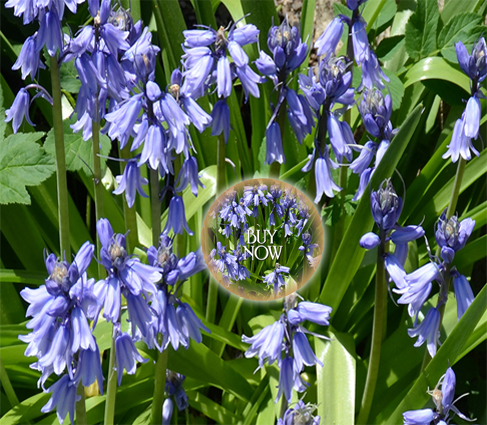3 of the Spring’s Most Historic Flowers
3 of the Spring’s Most Historic Flowers

Hyacinthoides Non-scripta – The English Bluebell
Buy Now for Fall Planting
We will be finishing the “Bulb Newsletters” in the next 2 weeks because you may be tiring of the subject, but we wouldn’t be Harvesting History if we didn’t persist in trying to teach you about the finer points of heirloom gardening and this includes reminding you of when things absolutely must be done. With respect to planting these flower bulbs, the time has come. In Hardiness Zones 1-4, you should be planting now.
You have at most 2-3 weeks left. In Hardiness Zones 5-7, you can start now and you have until the beginning of January. In Hardiness Zones 8-9, you can start planting in mid-November and continue through the Christmas holidays, but in Zones 8-9 you should refrigerate the bulbs for at least 8 weeks before planting.
Whether you plant directly in the ground or in containers, you must add bone meal to the soil. In containers you should double the amount recommended from the package. When planting bulbs err on the deep side – meaning, if it says plant 4-6 inches deep, make sure your bulbs are at least 6 inches deep. Sometimes this helps with critter control. I said ‘sometimes’.
Unless you are experiencing a severe drought, DO NOT water after planting your bulbs. Always plant more densely when planting bulbs in containers. The overpopulated effect is much more pleasant.
Native to the Mediterranean region, Hyacinthoides are also known as Scilla and commonly known as English or Spanish Bluebells. The plants were introduced into Europe centuries ago and became enormously popular especially in Britain where they are literally a national symbol of spring and probably one of the most beloved flowers of all time.
The plants are generally deer proof and are excellent naturalizers. They reach a height of 18 inches and are hardy from Hardiness Zones 4-8.
Plant 4” deep and 4” apart.

The Species Miniature Narcissus Jonquilla Simplex
Buy Now for Fall Planting
Jonquills are narcissus, but not all narcissus/daffodils are jonquils. Though they have been cultivated for hundreds of years, they still retain many characteristics of their wild form and they are quite vigorous and outstanding naturalizers.
Jonquills have extraordinary fragrance for their size and very interesting, attractive, rush-like foliage. Their flower stems produce 1-5 blossoms with petals that can either be spreading or reflexed and cups that can be funnel-shaped or flared.
Jonquilla Simplex is indigenous to central and southern Spain and southern and eastern Portugal where it grows in damp meadows and along stream beds. It does seem to relish damp soil, but needs to dry out during the summer. It was introduced into commercial cultivation around 1750.
The blossoms are vivid sunshine yellow. The plants can reach a height of 15 inches. The name, jonquilla comes from the Spanish word junquillo meaning ‘a rush’ and referring to the plant’s rush-like foliage.
This jonquil is very sturdy and an outstanding naturalizer. Bulbs should be planted 4-5 inches deep, so at least 5 inches deep and 4 inches apart. This plant usually blooms in mid-April.

Buy Now!
Leucojum, Snowflake Flowers, are closely related to Galanthus, The Snowdrop. Both have nodding white flowers with green markings, but Leucojum blooms much later than Galanthus. The Leucojum are unique in that they are truly native to the British Isles. Most bulbs that have been grown in England for centuries were not native to the Isles. They were brought there by the Romans before 476 AD.
Leucojum tolerate moist soils better than most bulbs. They can be planted by streams, swamps or ponds as long as they are above the high water mark. They are also rodent-proof and deer-resistant. They are excellent naturalizers.
Leucojum are hardy from Hardiness Zones 4-9. Plant the bulbs 6” deep and 6” apart.
Besides beauty, every garden benefits from the histories of the flowers being grown. These stories are better than fairytales because they are true. The three flowers whose stories we have shared with you today are, truly, some of the most historic or most beloved flowers of all time. They will flourish in your garden as they have in gardens around the world for centuries.
Celebrate your uniquely American horticultural heritage
Harvest Your History
Seed Your Future
https://www.harvesting-history.com
FREE SHIPPING
on orders $50 and above
Follow us on Instagram
https://www.instagram.com/harvestinghistory 
